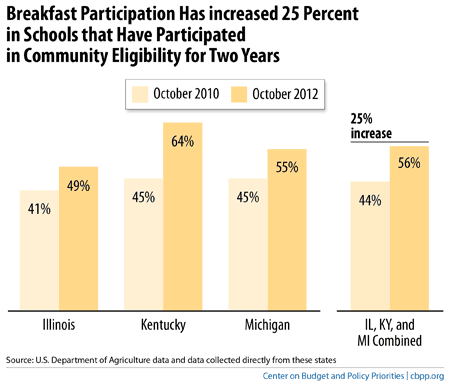BEYOND THE NUMBERS
With nearly 16 million children living in households that have trouble affording nutritious food at some point during the year, the time is right for thousands of schools serving high-poverty neighborhoods to adopt community eligibility, a powerful option to alleviate childhood hunger that will soon be available nationwide. The Community Eligibility Provision allows high-poverty schools to eliminate school meal applications and offer breakfast and lunch to all of their students at no charge.
Four thousand high-poverty schools across 11 states have already implemented community eligibility, and the White House estimates that 18,000 additional schools will be eligible to adopt the provision for the coming school year.
Community eligibility eliminates stigma and has led to a striking increase in the number of children eating breakfast and lunch at school. Daily lunch participation rose 13 percent in schools in Illinois, Kentucky, and Michigan that adopted the Community Eligibility Provision for two years. Even more remarkable, daily breakfast participation in these schools rose 25 percent (see chart). As a result, 29,000 more children were eating breakfast daily.

School districts will soon learn whether they qualify for community eligibility for the next school year — and they’ll need to act quickly to adopt the provision.
- By May 1, states must publish lists of schools that qualify to use the Community Eligibility Provision during the next school year.
- By June 30, school districts must decide if they want to offer community eligibility in some or all of their qualifying schools.
School districts that are considering adopting community eligibility can start preparing now. The U.S. Department of Agriculture has implementation guidance and a handy tool available so school districts can estimate their federal meal reimbursements under community eligibility. Additional resources, including materials developed by the states that have implemented the Community Eligibility Provision, are also readily available. Community eligibility has already ensured that low-income children in thousands of high-poverty schools receive two nutritious meals so they are ready to learn all day. Over the next three months, thousands more schools can choose to be hunger-free.
